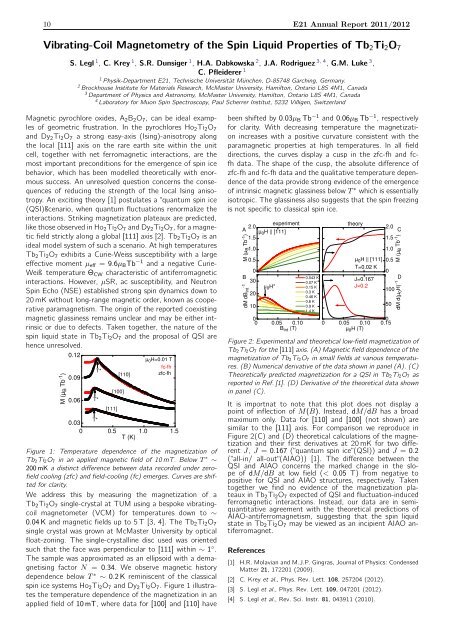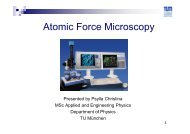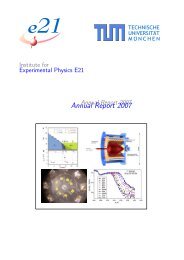Annual Report 2011 / 2012 - E21 - Technische Universität München
Annual Report 2011 / 2012 - E21 - Technische Universität München
Annual Report 2011 / 2012 - E21 - Technische Universität München
You also want an ePaper? Increase the reach of your titles
YUMPU automatically turns print PDFs into web optimized ePapers that Google loves.
10 <strong>E21</strong> <strong>Annual</strong> <strong>Report</strong> <strong>2011</strong>/<strong>2012</strong><br />
Vibrating-Coil Magnetometry of the Spin Liquid Properties of Tb 2 Ti 2 O 7<br />
S. Legl 1 , C. Krey 1 , S.R. Dunsiger 1 , H.A. Dabkowska 2 , J.A. Rodriguez 3, 4 , G.M. Luke 3 ,<br />
C. Pfleiderer 1<br />
1 Physik-Department <strong>E21</strong>, <strong>Technische</strong> Universität München, D-85748 Garching, Germany.<br />
2 Brockhouse Institute for Materials Research, McMaster University, Hamilton, Ontario L8S 4M1, Canada<br />
3 Department of Physics and Astronomy, McMaster University, Hamilton, Ontario L8S 4M1, Canada<br />
4 Laboratory for Muon Spin Spectroscopy, Paul Scherrer Institut, 5232 Villigen, Switzerland<br />
Magnetic pyrochlore oxides, A 2 B 2 O 7 , can be ideal examples<br />
of geometric frustration. In the pyrochlores Ho 2 Ti 2 O 7<br />
and Dy 2 Ti 2 O 7 a strong easy-axis (Ising)-anisotropy along<br />
the local [111] axis on the rare earth site within the unit<br />
cell, together with net ferromagnetic interactions, are the<br />
most important preconditions for the emergence of spin ice<br />
behavior, which has been modelled theoretically with enormous<br />
success. An unresolved question concerns the consequences<br />
of reducing the strength of the local Ising anisotropy.<br />
An exciting theory [1] postulates a “quantum spin ice<br />
(QSI)ßcenario, when quantum fluctuations renormalize the<br />
interactions. Striking magnetization plateaux are predicted,<br />
like those observed in Ho 2 Ti 2 O 7 and Dy 2 Ti 2 O 7 , for a magnetic<br />
field strictly along a global [111] axis [2]. Tb 2 Ti 2 O 7 is an<br />
ideal model system of such a scenario. At high temperatures<br />
Tb 2 Ti 2 O 7 exhibits a Curie-Weiss susceptibility with a large<br />
effective moment µ eff = 9.6µ B Tb −1 and a negative Curie-<br />
Weiß temperature Θ CW characteristic of antiferromagnetic<br />
interactions. However, µSR, ac susceptibility, and Neutron<br />
Spin Echo (NSE) established strong spin dynamics down to<br />
20 mK without long-range magnetic order, known as cooperative<br />
paramagnetism. The origin of the reported coexisting<br />
magnetic glassiness remains unclear and may be either intrinsic<br />
or due to defects. Taken together, the nature of the<br />
spin liquid state in Tb 2 Ti 2 O 7 and the proposal of QSI are<br />
hence unresolved.<br />
M (µ B Tb -1 )<br />
0.12<br />
0.09<br />
0.06<br />
T*<br />
T*<br />
[111]<br />
[100]<br />
[110]<br />
µ 0 H=0.01 T<br />
fc-fh<br />
zfc-fh<br />
T*<br />
0.03<br />
0 0.5 1.0 1.5<br />
T (K)<br />
Figure 1: Temperature dependence of the magnetization of<br />
Tb 2Ti 2O 7 in an applied magnetic field of 10 mT. Below T ∗ ∼<br />
200mK a distinct difference between data recorded under zerofield<br />
cooling (zfc) and field-cooling (fc) emerges. Curves are shifted<br />
for clarity.<br />
We address this by measuring the magnetization of a<br />
Tb 2 Ti 2 O 7 single-crystal at TUM using a bespoke vibratingcoil<br />
magnetometer (VCM) for temperatures down to ∼<br />
0.04K and magnetic fields up to 5 T [3, 4]. The Tb 2 Ti 2 O 7<br />
single crystal was grown at McMaster University by optical<br />
float-zoning. The single-crystalline disc used was oriented<br />
such that the face was perpendicular to [111] within ∼ 1 ◦ .<br />
The sample was approximated as an ellipsoid with a demagnetising<br />
factor N = 0.34. We observe magnetic history<br />
dependence below T ∗ ∼ 0.2K reminiscent of the classical<br />
spin ice systems Ho 2 Ti 2 O 7 and Dy 2 Ti 2 O 7 . Figure 1 illustrates<br />
the temperature dependence of the magnetization in an<br />
applied field of 10mT, where data for [100] and [110] have<br />
been shifted by 0.03µ B Tb −1 and 0.06µ B Tb −1 , respectively<br />
for clarity. With decreasing temperature the magnetization<br />
increases with a positive curvature consistent with the<br />
paramagnetic properties at high temperatures. In all field<br />
directions, the curves display a cusp in the zfc-fh and fcfh<br />
data. The shape of the cusp, the absolute difference of<br />
zfc-fh and fc-fh data and the qualitative temperature dependence<br />
of the data provide strong evidence of the emergence<br />
of intrinsic magnetic glassiness below T ∗ which is essentially<br />
isotropic. The glassiness also suggests that the spin freezing<br />
is not specific to classical spin ice.<br />
experiment<br />
2.0<br />
A µ 0 H || [111]<br />
1.5<br />
M (µ B Tb -1 )<br />
B<br />
dM dB int<br />
-1<br />
1.0<br />
0.5<br />
0<br />
30<br />
20<br />
10<br />
µ 0 H*<br />
0<br />
0 0.05 0.10<br />
B int (T)<br />
0.043 K<br />
0.07 K<br />
0.15 K<br />
0.3 K<br />
0.46 K<br />
0.6 K<br />
0.9 K<br />
1.4 K<br />
theory<br />
µ 0 H || [111]<br />
T=0.02 K<br />
J=0.167<br />
J=0.2<br />
0<br />
0 0.05 0.10 0.15<br />
µ 0 H (T)<br />
Figure 2: Experimental and theoretical low-field magnetization of<br />
Tb 2Ti 2O 7 for the[111] axis. (A) Magnetic field dependence of the<br />
magnetization of Tb 2Ti 2O 7 in small fields at various temperatures.<br />
(B) Numerical derivative of the data shown in panel (A). (C)<br />
Theoretically predicted magnetization for a QSI in Tb 2Ti 2O 7 as<br />
reported in Ref. [1]. (D) Derivative of the theoretical data shown<br />
in panel (C).<br />
It is importnat to note that this plot does not display a<br />
point of inflection of M(B). Instead, dM/dB has a broad<br />
maximum only. Data for [110] and [100] (not shown) are<br />
similar to the [111] axis. For comparison we reproduce in<br />
Figure 2(C) and (D) theoretical calculations of the magnetization<br />
and their first derivatives at 20 mK for two different<br />
J, J = 0.167 (“quantum spin ice“(QSI)) and J = 0.2<br />
(“all-in/ all-out“(AIAO)) [1]. The difference between the<br />
QSI and AIAO concerns the marked change in the slope<br />
of dM/dB at low field (< 0.05 T) from negative to<br />
positive for QSI and AIAO structures, respectively. Taken<br />
together we find no evidence of the magnetization plateaux<br />
in Tb 2 Ti 2 O 7 expected of QSI and fluctuation-induced<br />
ferromagnetic interactions. Instead, our data are in semiquantitative<br />
agreement with the theoretical predictions of<br />
AIAO-antiferromagnetism, suggesting that the spin liquid<br />
state in Tb 2 Ti 2 O 7 may be viewed as an incipient AIAO antiferromagnet.<br />
References<br />
[1] H.R. Molavian and M.J.P. Gingras, Journal of Physics: Condensed<br />
Matter 21, 172201 (2009).<br />
[2] C. Krey et al., Phys. Rev. Lett. 108, 257204 (<strong>2012</strong>).<br />
[3] S. Legl et al., Phys. Rev. Lett. 109, 047201 (<strong>2012</strong>).<br />
[4] S. Legl et al., Rev. Sci. Instr. 81, 043911 (2010).<br />
2.0<br />
1.5<br />
1.0<br />
0.5<br />
0<br />
100<br />
50<br />
C<br />
M (µ B Tb -1 )<br />
D<br />
dM d(µ 0 H) -1




